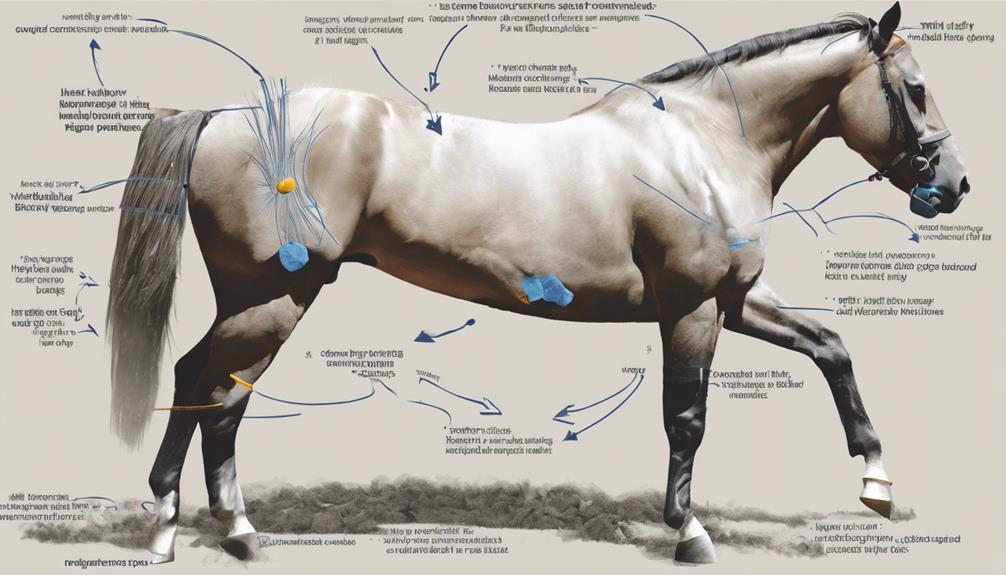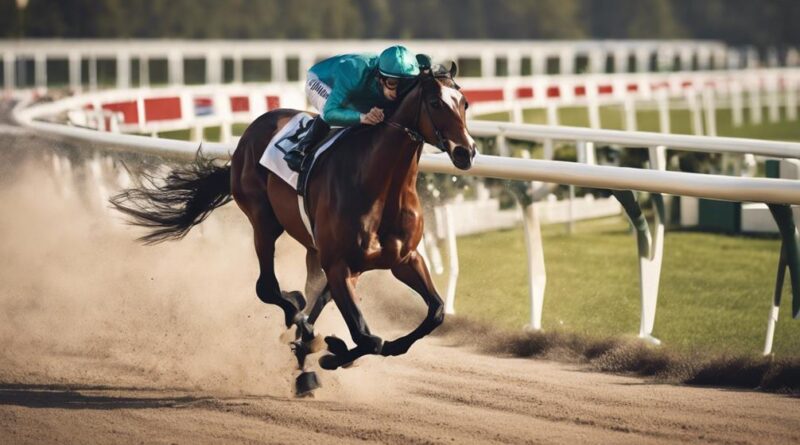Why Does Equine Biomechanics Influence Racing Performance?
When you watch a racehorse like Secretariat effortlessly galloping down the track, have you ever wondered why some horses seem to have that extra edge? Equine biomechanics holds the key to unlocking the mysteries behind their performance.
From the way their muscles power each stride to the intricate angles of their joints, every aspect plays a crucial role in determining how they fare on the racetrack. But how exactly do these biomechanical factors come together to create a winning combination?
Let's unravel the science behind equine biomechanics and its undeniable impact on racing performance.
Understanding Equine Biomechanics
To understand equine biomechanics, focus on how a horse's physical structure and movement mechanics impact its performance in racing. Gait analysis plays a crucial role in evaluating how a horse moves during different phases of its stride. By studying locomotion patterns, experts can identify areas where energy efficiency can be optimized to enhance overall performance. A horse's gait, whether it be a walk, trot, canter, or gallop, determines its speed and endurance on the track.
When analyzing equine biomechanics, experts look at how a horse distributes its weight while in motion. Understanding weight distribution helps in optimizing performance by ensuring that the horse moves efficiently and with minimal energy expenditure. By fine-tuning locomotion patterns, trainers can help horses achieve their maximum potential on the racetrack.
Performance optimization is the ultimate goal when delving into equine biomechanics. By honing in on the intricate details of a horse's movement mechanics, trainers and veterinarians can work together to enhance the animal's capabilities. From adjusting training regimens to implementing specific exercises, every aspect of the horse's biomechanics can be fine-tuned to achieve peak performance. By prioritizing energy efficiency and perfecting locomotion patterns, the horse can reach its full potential on the racetrack.
The Role of Stride Length
Understanding equine biomechanics, particularly focusing on stride length, plays a crucial role in optimizing a horse's racing performance. When it comes to the role of stride length in equine biomechanics, there are several key points to consider:
- Speed Potential: A horse's stride length directly impacts its speed potential on the racetrack. Longer strides allow the horse to cover more ground with each step, leading to increased speed and faster race times.
- Racing Efficiency: Optimizing stride length is essential for enhancing racing efficiency. By finding the right balance between stride length and frequency, a horse can maintain a steady pace while conserving energy for the final stretch.
- Biomechanical Advantage: Proper biomechanics, including an optimal stride length, give horses a competitive edge on the track. A well-coordinated gait ensures maximum efficiency in movement, translating into improved performance during races.
- Training Focus: Trainers and jockeys often work on adjusting a horse's stride length during training sessions to improve its overall racing performance. By fine-tuning this aspect of biomechanics, they aim to unleash the horse's full speed potential and achieve better results on race day.
Impact of Hoof Dynamics
Exploring the impact of hoof dynamics on equine biomechanics reveals crucial insights into a horse's racing performance. The condition of a horse's hooves directly affects how it moves and performs during races. Hoof wear plays a significant role in determining the horse's grip on different surfaces. Proper shoeing techniques are essential to maintain optimal hoof health and performance.
Hoof wear is a critical aspect of hoof dynamics that affects racing performance. The wear patterns on a horse's hooves can indicate imbalances in its gait or weight distribution. By analyzing the wear on the hooves, trainers and farriers can make adjustments to improve the horse's biomechanics and overall performance on the track.
Shoeing techniques are another crucial factor in hoof dynamics. The type of shoes, how they're fitted, and the materials used can all impact how a horse moves. Properly fitted shoes provide support and traction, enhancing the horse's performance. Different racing conditions may require specific shoeing techniques to optimize grip and stability.
Importance of Muscle Power
Muscle power significantly influences an equine athlete's speed and strength on the racetrack. Here are key ways in which muscle power impacts racing performance:
- Muscle Strength: The level of muscle power directly correlates with the strength an equine athlete can exert during a race. Strong muscles enable the horse to push off the ground with more force, leading to faster acceleration and increased speed on the track.
- Speed Control: Muscles play a vital role in regulating the speed of the horse. Strong and well-developed muscles allow the equine athlete to maintain control over its pace, especially during crucial moments like sprints or navigating tight turns. The ability to adjust speed efficiently can make a significant difference in a race's outcome.
- Endurance: Muscle power is crucial for maintaining stamina and endurance throughout a race. Well-conditioned muscles help prevent fatigue and enable the horse to sustain its speed over long distances, giving it a competitive edge against opponents.
- Injury Prevention: Adequate muscle power is essential for supporting the skeletal structure and joints during high-intensity activities like racing. Strong muscles help absorb shock and reduce the risk of injuries, ensuring the equine athlete can perform at its best without compromising its well-being.
Analyzing Joint Angles
Analyzing joint angles provides valuable insights into an equine athlete's biomechanics during racing performance. Joint flexibility plays a crucial role in determining a horse's performance on the track. The range of motion in joints like the hock, stifle, and fetlock directly impacts the horse's ability to generate power and speed. By studying the joint angles during different phases of the stride, trainers and veterinarians can assess the efficiency of the horse's movement and make adjustments to optimize performance.
Biomechanics is the science behind how a horse moves and performs athletic tasks, including racing. Joint angles are a key component of equine biomechanics, as they influence the distribution of forces throughout the horse's body. During high-speed activities like racing, the angles at which joints flex and extend can significantly affect speed and efficiency. By analyzing joint angles, trainers can identify potential areas for improvement and develop training strategies to enhance the horse's overall performance.
Influence of Posture and Balance
To understand the impact of posture and balance on an equine athlete's racing performance, one must consider how these factors interact with joint angles to optimize speed and efficiency on the track. Posture analysis plays a crucial role in ensuring that the horse maintains the correct alignment of its head, neck, back, and legs during movement. By evaluating the horse's posture, trainers and veterinarians can identify any asymmetries or imbalances that may affect its performance.
When it comes to improving balance in horses, various techniques can be employed to enhance their stability and coordination on the track:
- Core Strengthening Exercises: Engaging the horse in specific exercises that target its core muscles can help improve overall balance and stability.
- Proper Hoof Care: Ensuring that the horse's hooves are properly trimmed and balanced is essential for maintaining stability and preventing injuries.
- Regular Bodywork Sessions: Massage therapy and chiropractic adjustments can help address any physical imbalances and promote better posture and balance.
- Rider's Position: The rider's position and balance on the horse also play a significant role in influencing the horse's own posture and balance. Proper alignment and weight distribution by the rider can positively impact the horse's performance on the track.
Effect of Ground Interaction

Optimizing the way a horse interacts with the ground can significantly impact its racing performance. Ground reaction forces play a crucial role in how a horse moves and accelerates during races. When a horse gallops, the ground reaction forces generated with each hoof strike propel the horse forward. Efficiently managing these forces is key to maximizing speed and endurance.
Hoof loading is another essential aspect of ground interaction. The way a horse's hooves distribute pressure when in contact with the ground affects its stability and performance. Proper hoof loading ensures that the horse can push off effectively with each stride, leading to smoother and more powerful movement.
Enhancing Performance Through Biomechanics
Improving racing performance can be achieved by leveraging the principles of biomechanics to optimize a horse's movement efficiency and power. By incorporating specific training techniques and making biomechanical adjustments, you can significantly enhance your horse's performance on the track.
Here are four key ways in which biomechanics can help enhance racing performance:
- Utilizing Advanced Training Techniques: Implementing specialized training programs that focus on enhancing specific muscle groups and improving coordination can lead to significant performance outcomes. By tailoring training routines to address biomechanical inefficiencies, you can help your horse move more efficiently and powerfully.
- Analyzing Biomechanical Data: Utilize advanced technology to gather biomechanical data during training sessions and races. Analyzing this data can help identify areas where biomechanical adjustments are needed to optimize performance. By making targeted changes based on this analysis, you can enhance your horse's racing success.
- Optimizing Stride Length and Frequency: Understanding how biomechanics influence stride length and frequency can help you fine-tune your horse's gait for maximum speed and efficiency. Making adjustments to improve stride mechanics can have a direct impact on racing performance.
- Enhancing Muscle Strength and Propulsion: By focusing on developing specific muscle groups critical for propulsion, such as the glutes and hamstrings, you can enhance your horse's power output during races. Strengthening these muscles through targeted exercises can lead to improved speed and performance outcomes on the track.
Frequently Asked Questions
How Does the Weight of the Jockey Affect the Equine Biomechanics and Racing Performance?
When you consider how the weight of the jockey impacts equine biomechanics and racing performance, it's crucial to focus on jockey positioning and saddle impact.
The weight distribution affects the horse's balance and stride length, directly influencing speed and efficiency.
Proper equipment choice and rider balance are key factors in optimizing performance.
Can the Type and Quality of the Horse's Diet Impact Its Biomechanics During a Race?
When it comes to your horse's performance on the track, the type and quality of their diet can have a significant impact.
The effect of supplements and the training regimen play a crucial role in optimizing your horse's biomechanics during a race.
What Role Does the Horse's Mental State and Temperament Play in Its Biomechanics and Racing Performance?
When it comes to racing performance, your horse's mental state and temperament are key players. Stress management is crucial for optimal performance.
Emotions can affect gait analysis, impacting how your horse moves during a race. Keeping your horse calm and focused can lead to better biomechanics and, ultimately, improved racing performance.
Understanding and addressing your horse's mental well-being is just as important as physical training for achieving success on the track.
Are There Specific Training Techniques or Exercises That Can Improve a Horse's Biomechanics for Racing?
To improve your horse's biomechanics for racing, focus on strength training and flexibility exercises.
By incorporating biomechanical analysis into your training regimen, you can identify areas for improvement and tailor exercises accordingly.
This targeted approach can optimize your horse's performance and help enhance its racing capabilities.
How Do Environmental Factors, Such as Weather Conditions or Track Surface, Influence Equine Biomechanics and Racing Performance?
In racing, environmental factors like weather and track surface can significantly affect equine biomechanics and performance. Altitude impacts oxygen levels, influencing a horse's stamina and speed.
Track conditions, such as firm or muddy surfaces, can alter stride length and stability, affecting racing strategy. Understanding how these variables impact your horse's biomechanics allows for adjustments in training and race tactics to optimize performance in diverse environments.
Conclusion
You have learned that equine biomechanics plays a crucial role in racing performance. From stride length to muscle power, every aspect contributes to the horse's ability to perform at its best.
By understanding and optimizing biomechanics, trainers and riders can enhance the horse's speed, agility, and overall performance on the track.
So, next time you watch a horse race, remember the importance of biomechanics in determining the outcome.
